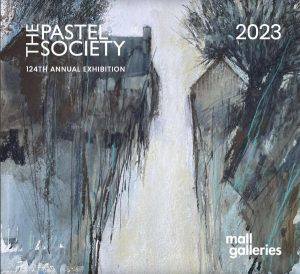Painting a Master Copy – Jackson’s Art Blog

Painting a Master copy can be an excellent way to expand your painting practice. Cristina Vercesi of London Fine Art Studios shares her experience of painting in the Galleria Ricci Oddi in Piacenza, Italy, with information on seeking permission from the gallery, selecting materials and a colour palette, and the lessons she learned along the way.
Cristina Vercesi Shares Her Experience of Painting a Master Copy
As a classically trained artist and part-time tutor at London Fine Art Studios, I’m currently working on a project for an upcoming exhibition, which involves digging deeper into my Italian roots, while continuing to evolve as an artist.
These two perspectives led me to consider completing a master copy of one of Antonio Mancini’s paintings. His eclectic use of texture, and eccentric painterly approach offered something special I could learn from. In the past I have tried to study his painting from photos but I felt that I was missing out on the intense natural feeling that his paintings produce when seen in person.

La Servetta, 1885 – 1890
Antonio Mancini
Oil on canvas, 100 x 60 cm | 39.3 x 23.6 in
Galleria Ricci Oddi, Piacenza
I decided to try to fulfil one of my long-cherished dreams: to embark on this beautiful master copy journey. As I grew up and spent most of my school years in the beautiful city of Piacenza, I knew of the Galleria Ricci Oddi, which offers a spectacular selection of Italian artwork dating from the mid-1800s to early 1900s. One of the rooms houses nine paintings by Antonio Mancini. In September 2022, I contacted gallery director, Mrs Pini, to propose my idea of a Copia d’artista, or master copy of the painting La Servetta. It was not easy to choose between all the fantastic images of Mancini the gallery offers, so I selected the one I believed had the most textural variety.

Cristina painting in the Galleria Ricci Oddi, Piacenza
Applying to Paint a Master Copy at Galleria Ricci Oddi
For my idea to be considered, I needed to submit my CV, a referral letter from London Fine Art Studios, along with my plan for the project. In my proposal plan, I specified which painting I was interested in copying, the dates I was available, the medium chosen and the size of my canvas. To progress, my project needed to be approved by the gallery’s Board of Governors.
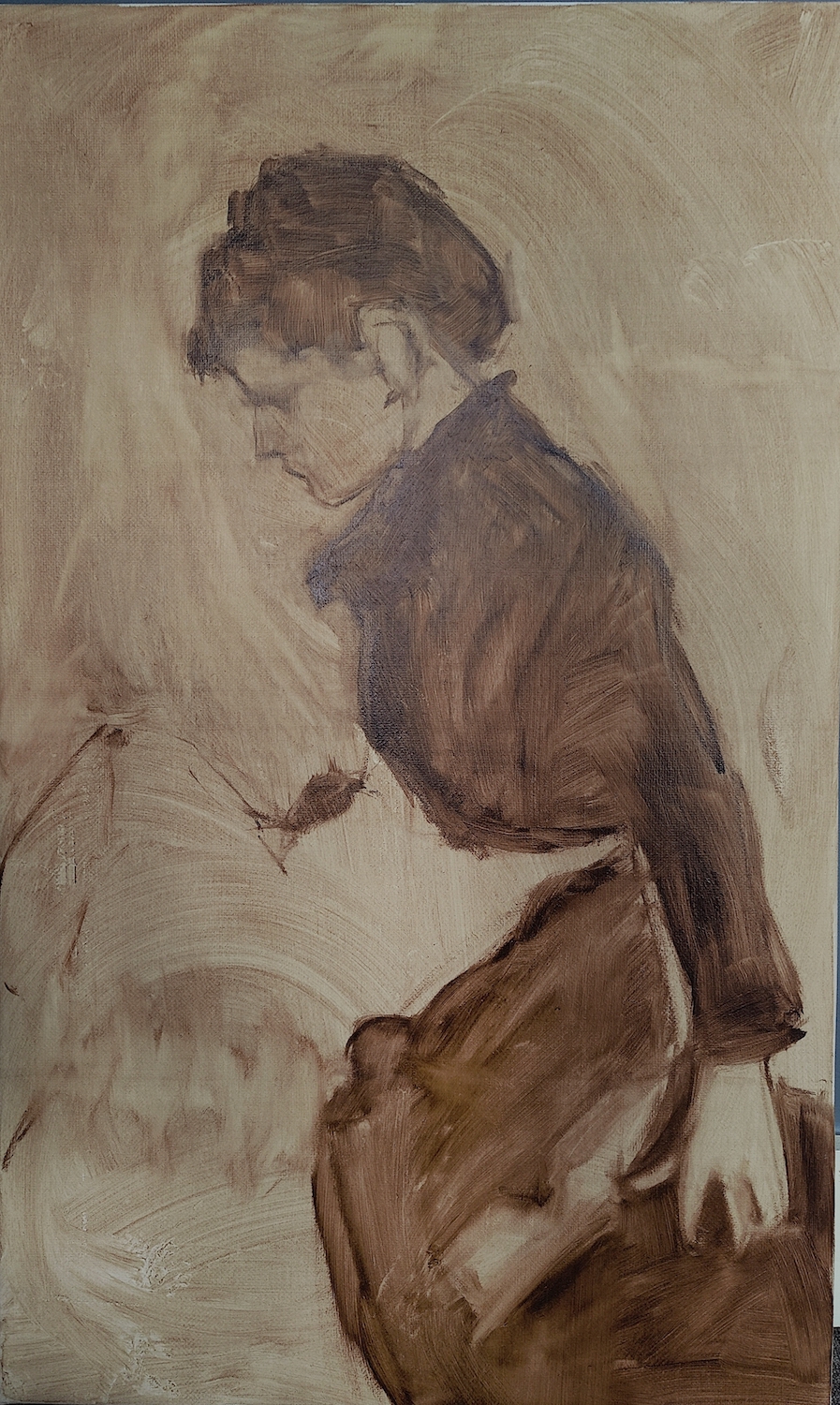
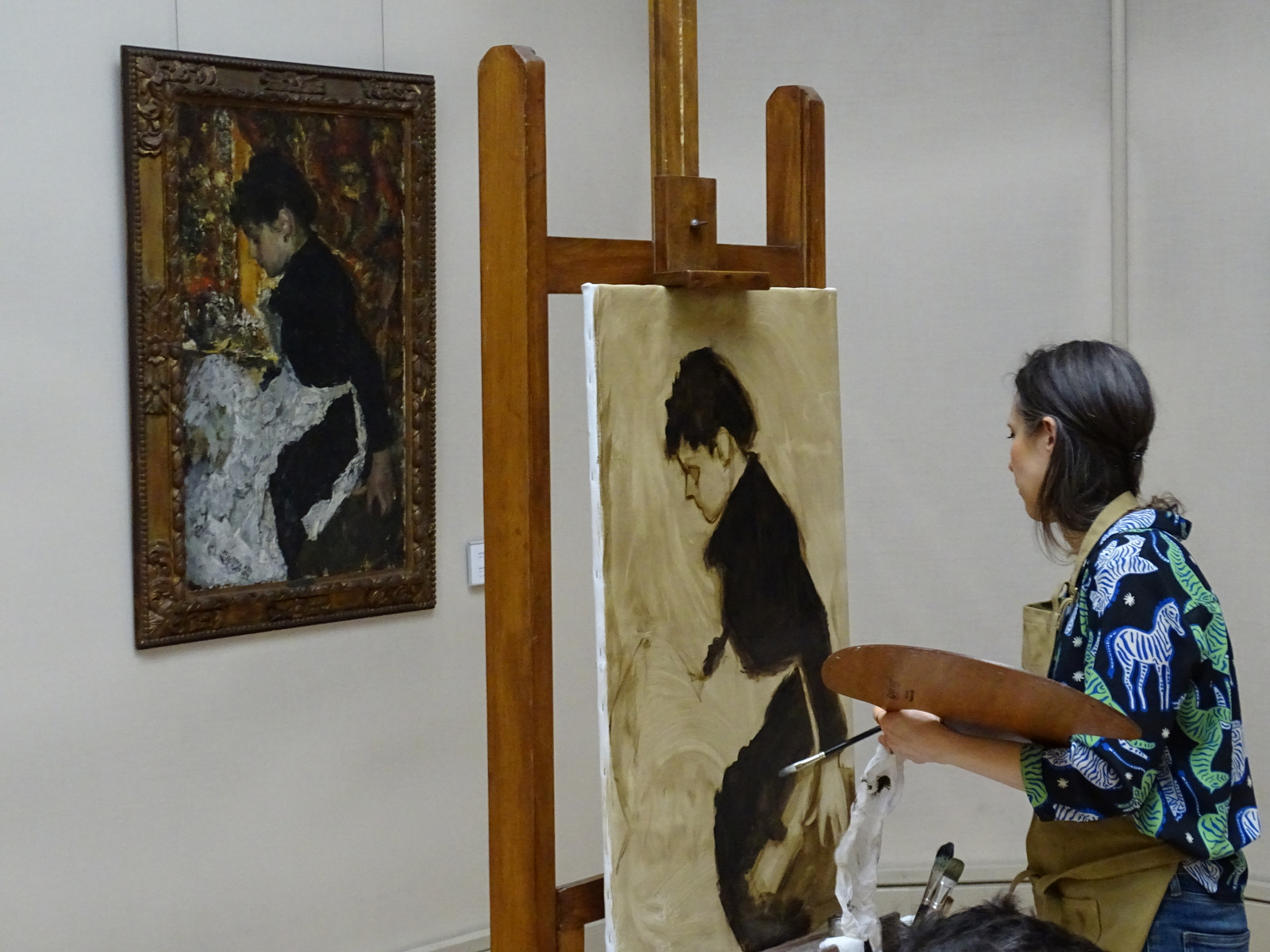
In January 2023, the long-awaited email giving the gallery’s approval finally arrived. Now I had to think about the practical side of my project; I booked my flight and accommodation in Piacenza. Except for the stretcher bars and solvent, which were purchased in Italy, I carried everything with me from England. My master copy was painted from 25th March to 3rd April, although I didn’t paint every day as I had to follow the gallery opening hours.
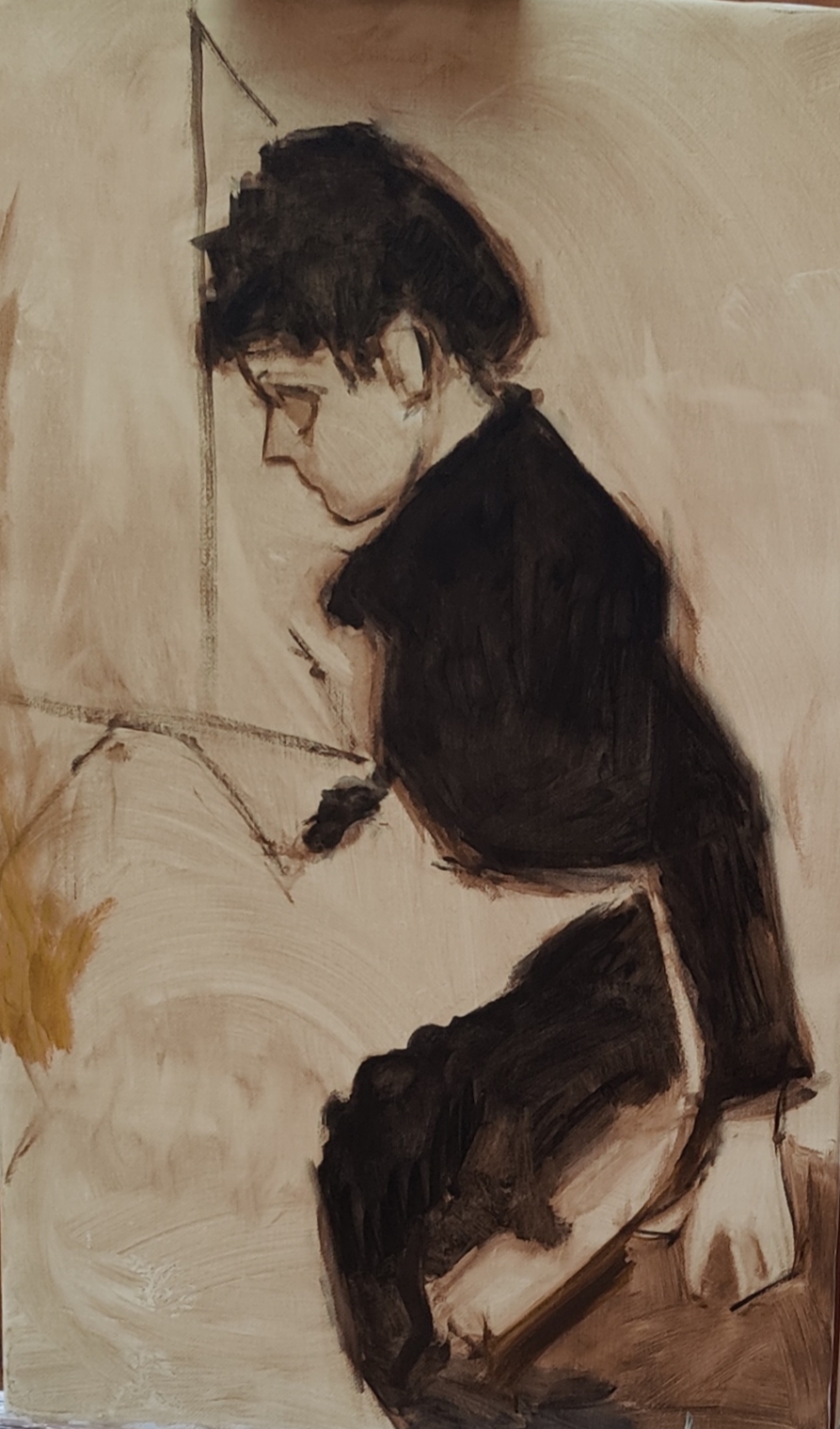
Should you be interested in producing a Master copy, I suggest looking at galleries and museums which house paintings that interest you and get in touch with them. Some galleries may have a long waiting list or may go through a selection process, but please don’t get disheartened. I felt that way at times as I was going through my application. However, it’s a unique experience that gifts you with endless inspiration and ideas, and you will leave with acquired knowledge.

Choosing Materials and Colour Palette
Preparing for the master copy was easier than I initially envisaged. The original painting is 100 x 60 cm (40 x 26 in). I decided to go life-size as it would have been hard to study Mancini’s unique painterly approach on a smaller scale. My paint and canvas were purchased from Jackson’s Art Supplies. For my surface, I decided to use Belle Arti Universal Primed Jute No. 565, 584 gsm, which I highly recommend if you’re trying to be more textural. I rolled my burlap inside a sturdy tube for transport; it passed the endurance test with full marks. It doesn’t flake or crack, it’s a sturdy surface. Belle Arti Universal Primed Jute No. 565, 584 gsm will now be a new painting companion for me. It forces the artist to be braver, to use more paint and in return, it’s a reliable painting surface.


For my palette, I mainly choose earthy colours of Michael Harding Oil Paints: Ivory Black, Raw Umber, Burnt Sienna, Transparent Oxide Red, Permanent Sap Green, Alizarin Crimson, Scarlet Lake, Cadmium Red Light, Transparent Oxide Yellow, Cadmium Yellow and Titanium White No. 2.

Cristina’s palette of Michael Harding Oil Paints
While I didn’t have any problem while travelling with my paint – you can download a travel certificate from Michael Harding’s website – please remember to store your paint in your checked luggage. On top, I used linseed oil and liquin to speed up the drying time.
New Wave Expressionist Confidant Wood Palette proved invaluable, allowing me to paint freely with a large amount of paint. It’s also so light that I didn’t even notice its weight.
The gallery provided a wooden easel for me. At the end of each session, I ensured my working area was left in excellent condition.
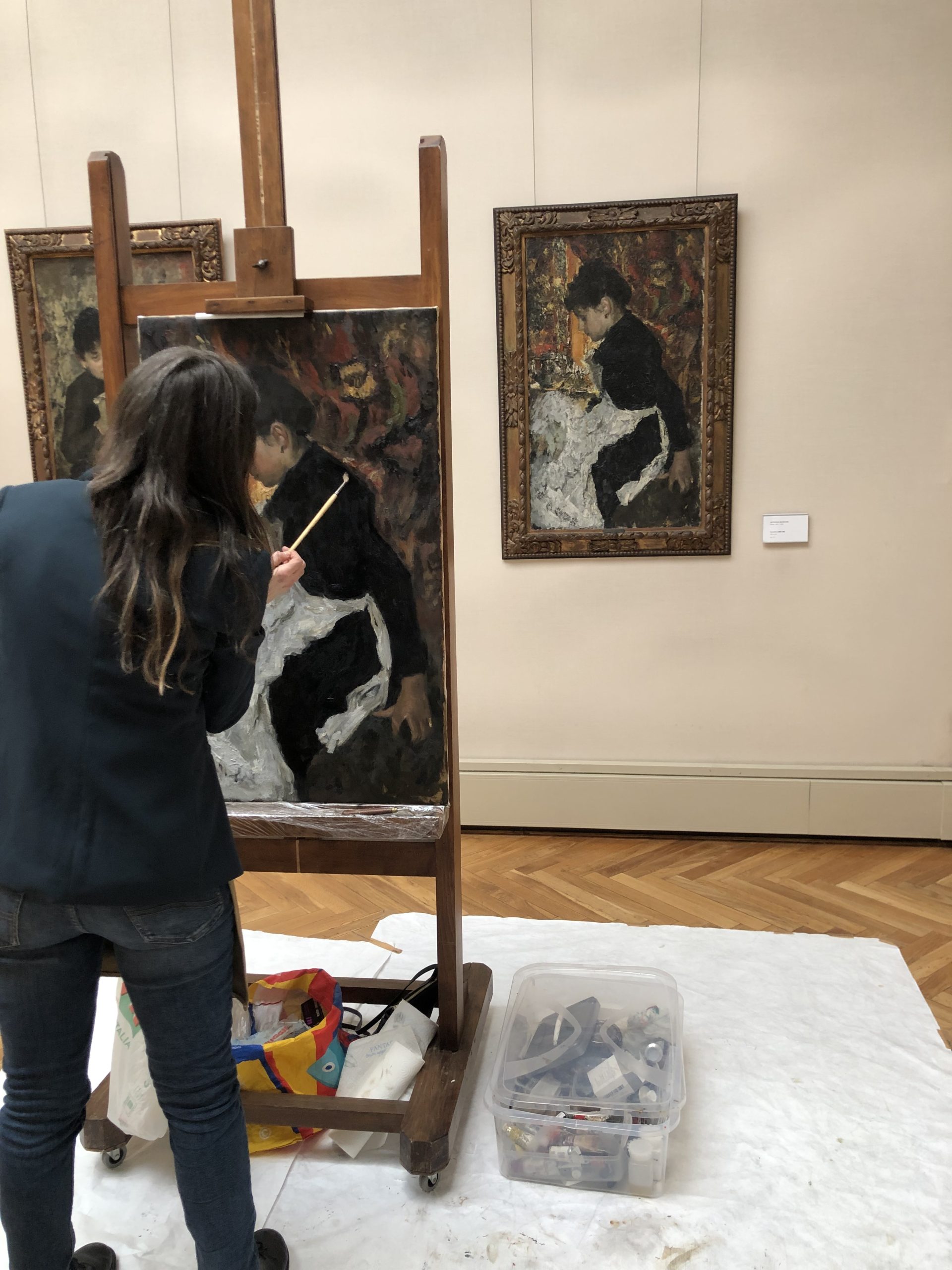
Painting in the Gallery
I did a few thumbnail sketches of this painting to have an idea of the composition and the main value shapes. I didn’t do any colour study as I felt that his palette was pretty limited and not too complicated.
My main goal wasn’t to produce an identical version of the painting but to understand Mancini’s thinking process in making the painting. It took me around 25 hours to finish the picture, but I am convinced it took Mancini at least half that time. His idea seems to appear as a highly intuitive and natural piece of work; his understanding of value, chroma, composition and anatomy is second nature to him, so I am sure that he wouldn’t even have to think about certain aspects in any depth.

I started with a basic Imprimatura (a thin wash of transparent pigment on the canvas) of the central figure, slowly increasing the thickness of the layers over the week. I kept the areas of the face reasonably thin, as it appears in Mancini’s version. Everything else was pretty textural and thick. I mainly used large Filbert and Round Hog Brushes with few exceptions for a Size 2 Round Hog Brush, which was used for details such as the accents in the eyes and ring.
At one point, I used so much paint to describe the texture of the teapot and flowers that I felt like a sculptor. After all, Mancini spent many years working alongside his peer Vincenzo Gemito, a well-known sculptor, so I wonder if his friendship also contributed to the phenomenal textural language we see in his paintings.

Observations Through Copying the Master Painting
The longer I worked on the painting, the more I discovered the most subtle brushstrokes on the original painting, as if Mancini purposely created them for the fine observer, like a gift given only to those willing to absorb his work visually. For example, I discovered after a few days of working on it that Mancini added some element of embroidery to the apron; I also noticed that he distorted the shape of the shoulder towards the end of the painting by covering the area with the background. In this way, he emphasised the importance of the zig-zag line in the body, adding a sense of dynamism and complementing them with the directional lines of the curtains on the top right corner.

One of my biggest challenges was to learn how to juggle the never-ending different textures and techniques. From the thin veil of paint barely staining cheeks of the subject with a timid red, to the vast gobs of impasto looking as if they have been chunked onto the surface with a palette knife, squeezing paint directly from the tube onto the canvas and mixing it with muted colours. The adjective painterly is inadequate to describe the way Mancini mounded, scooped, troweled and scraped back across the canvas in places which allowed him to create a piece of work with the most sublime modelling and blending.
In addition to working at the extreme of the texture scale, copying Mancini has made me drop my fear of perfection, which is exactly what I was hoping to achieve to evolve artistically.
I was taken by an explanation I found in “Art and Fear“ by David Byles:
“The lessons you are meant to learn are in your work. To see them, you need only look at the work clearly – without judgement, without need or fear, without wishes or hopes, without emotional expectations. Ask your work what it needs, not what you need. Then set aside your fears and listen as a good parent listens to a child.”

Indeed, this experience has made me more adventurous about my approach, leaving me inspired. I am very grateful to everyone who helped me achieve this, from London Fine Art Studios to the Galleria Ricci Oddi and the Great Master Mancini himself, for the beautiful lesson I learnt from him.

About Cristina Vercesi
Cristina is a classically trained artist who currently lives and works in the UK. She takes commissions for portraits and still life, working primarily from life whenever possible, as she believes only the artist’s eye can capture subtle visual information and vital energies that a camera cannot see.
Cristina grew up in Italy where she started to nurture her appreciation for art from a very young age. One of her first memories as a child was a trip to the Uffizi Gallery in Florence which ignited a long-lasting passion for art. In 2017 Cristina decided to join London Fine Art Studios in London where she developed a deeper understanding of figurative art and where she now teaches part-time. In 2021 she was awarded the De Laszlo Scholarship.
She is always looking for different ways to allow her art to evolve naturally. Cristina is an avid collector of art books, always searching for more information not only about the most celebrated artists but in particular the ones whose incredible works and lives have been forgotten about.
Cristina is inspired by Verism and Scapigliatura which developed in Italy at the end of the 19th century. Cristina will be taking part of the Royal Society of portrait painters annual exhibition 4 – 14 May 2023
Otherland is a group exhibition featuring Cristina’s work at Green & Stone Gallery, London from 11th – 17th September, 2023. The exhibition will be about the different cultural backgrounds of the artists.
Further Reading
A Guide to Oil Painting
Oil Painting for Beginners: What You Need to Get Started
Creating Oil Paintings That Stand the Test of Time
Two Artists Test Jackson’s Premium Stretched Linen Canvas
Shop Oil Painting on jacksonsart.com



